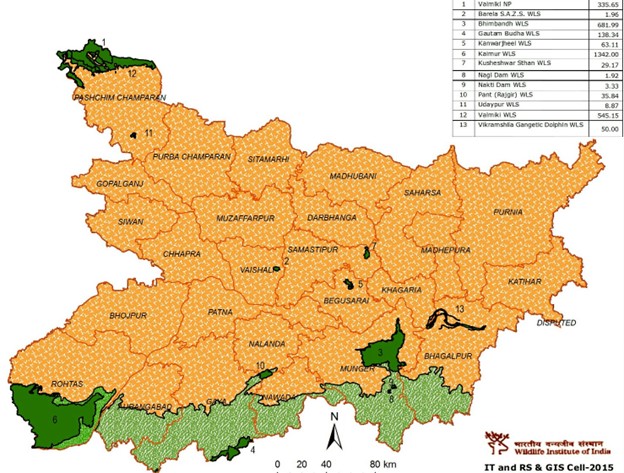Important Facts For Prelims
Increase Tiger Numbers in Valmiki Tiger Reserve
- 27 Dec 2023
- 4 min read
Why In News?
Recently, the National Tiger Conservation Authority (NTCA) had officially announced the increase in tiger population in Valmiki Tiger Reserve (VTR).
- It witnessed the growth in the number of big cats from 31 (2018) to 54 (2023).
- The Bihar government is waiting to obtain NTCA approval for declaring Kaimur Wildlife Sanctuary as the state’s second tiger reserve after VTR.
Why Has the Number of Tigers in VTR Increased?
- A total ban on sand and stone mining inside VTR, and strict restrictions on mining in its eco-sensitive zone, helped increase grassland cover.
- An increase in grassland cover thus helps in supporting the prey population, in turn increasing the chances of the carnivores’ survival.
- The reserve is dedicated to managing and sustaining the tiger population by raising awareness among local residents and monitoring mining activities in and around the area to minimize human-wildlife conflict.
- The NTCA placed the reserve in the ‘Very Good’ category.
What are the Important Facts of Valmiki Tiger Reserve (VTR)?
- The VTR is the only tiger reserve in Bihar, which forms the easternmost extent of the Himalayan Terai forests in India.
- The VTR is located in Bihar’s West Champaran district, bordering Nepal to its north and Uttar Pradesh to its west.
- Situated in the Gangetic plains bio-geographic region, the vegetation of this Tiger Reserve is a combination of Bhabar and Terai regions.
- According to the Forest Survey of India Report 2021, 85.71% of its total area is covered by forest cover.
- Wild mammals found in the forests of Valmiki Tiger Reserve include tiger, sloth bear, leopard, wild dog, bison, wild boar etc.
- Rivers Gandak, Pandai, Manor, Harha, Masan and Bhapsa flow through various parts of the reserve.
What is the National Tiger Conservation Authority (NTCA)?
- About:
- National Tiger Conservation Authority (NTCA) is a statutory body under the Ministry of Environment, Forests and Climate Change.
- It was established in 2005 following the recommendations of the Tiger Task Force.
- It was constituted under enabling provisions of the Wildlife (Protection) Act, 1972, as amended in 2006, for strengthening tiger conservation, as per powers and functions assigned to it.
- Objectives:
- Providing statutory authority to Project Tiger so that compliance of its directives becomes legal.
- Fostering accountability of Center-State in management of Tiger Reserves, by providing a basis for MoU with States within our federal structure.
- Providing for an oversight by Parliament.
- Addressing livelihood interests of local people in areas surrounding Tiger Reserves.
UPSC Civil Services Examination, Previous Year Question (PYQ)
Q1. Consider the following protected areas: (2012)
- Bandipur
- Bhitarkanika
- Manas
- Sunderbans
Which of the above are declared Tiger Reserves?
(a) 1 and 2 only
(b) 1, 3 and 4 only
(c) 2, 3 and 4 only
(d) 1, 2, 3 and 4
Ans: (b)
Q2. From the ecological point of view, which one of the following assumes importance in being a good link between the Eastern Ghats and the Western Ghats? (2017)
(a) Sathyamangalam Tiger Reserve
(b) Nallamala Forest
(c) Nagarhole National Park
(d) Seshachalam Biosphere Reserve
Ans: (a)





